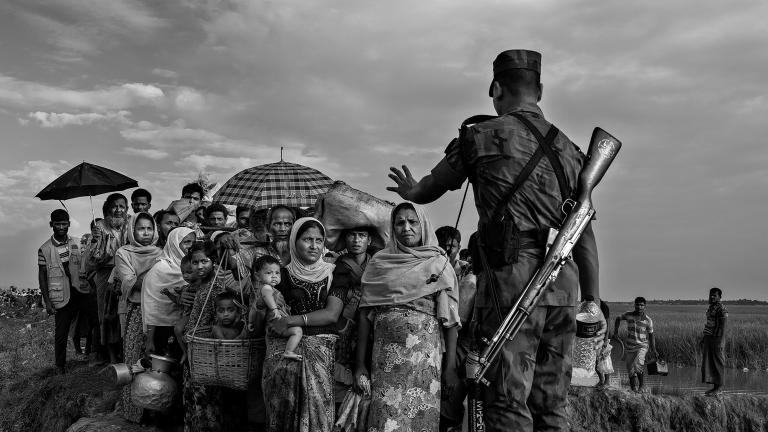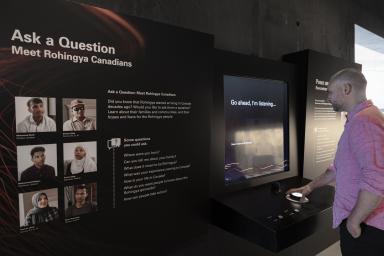This release is more than two years old
This release is more than two years old. For additional information, please contact Amanda Gaudes from our Media Relations team.
News release details
The humanitarian crisis now facing hundreds of thousands of Rohingya families forced to flee their homes in Myanmar and survive a genocide comes into sharp focus in a new exhibition opening June 16 at the Canadian Museum for Human Rights (CMHR).
Time to Act: Rohingya Voices features images by internationally renowned photojournalist Kevin Frayer that compassionately portray the desperate and ongoing plight of a people struggling to survive violent persecution and dehumanization. Huge, projected black‐and‐white photographs are layered in the Museum’s Level 6 Expressions gallery, interspersed with animated design elements that suggest the displacement, movement and continual relocation of a stateless people.
“I had gone with the hope of making a contribution to telling the story, but you always feel like you never photograph enough. Or see enough. Or hear enough,” said Frayer, a former Winnipegger and Pulitzer Prize finalist, most recently for this body of work. “If the pictures – no matter how fleeting – can cause people to be moved to care in some way, then it is worth it.”
The exhibition also includes a voice‐activated interactive where Rohingya‐Canadians directly answer visitors’ verbal questions about their lives and concerns via pre‐recorded video clips. Community members also participated in the exhibition’s development and contributed artifacts and additional images. The artifacts reflect both the repression of rights and the long, rich history of Rohingya cultural traditions. The colour photographs they supplied reveal the resilient humanity of a people seeking hope while confronting daily challenges to survival.
Yasmin Ullah of Vancouver said she was moved to embrace her Rohingya identity and become an activist for the refugees as she became increasingly aware of what was happening to her people, including members of her extended family. “I realized that if people like me, who are in the diaspora outside the country, do not take care of our culture, it will die,” said Ullah, 27. “For the people in the camps, their concern is not, ‘How do we keep the culture alive?’ Their concern is survival.”
A talk‐tour on the theme of the exhibition will run daily from Monday to Friday starting July 2 at 11 a.m. in English and 1:30 p.m. in French. In addition, a series of monthly human rights conversation circles on aspects of the Rohingya crisis will begin in October.
The Museum has also developed an online resource guide for more information about the ongoing crisis and how Canadians can take action. The guide includes links to books, articles, statistics, conference proceedings, documentaries, cultural materials, community resources, government publications and much more.
The Rohingya people are an ethnic population, largely Muslim, with a distinct culture and language, who have deep roots in the Rakhine state of Myanmar (formerly called Burma). For decades, the government of Myanmar has denied them rights and citizenship, while the military conducts massacres and destroys their communities – a genocide that continues today.
Last year, the United Nations and the Government of Canada both condemned the atrocities committed against the Rohingya people and declared the situation a genocide. The CMHR dimmed the light on its exhibit images of Myanmar’s defacto leader Aung San Suu Kyi to help raise awareness and acknowledge concerns that she has failed to condemn these attacks. Her honorary Canadian citizenship was revoked last year. Last September, the Museum also hosted a dialogue event, developed with the Rohingya community in Canada, about the refugee crisis as an emergent human rights issue.
About the photographer
Kevin Frayer is an award‐winning Canadian photojournalist. A three‐time Pulitzer Prize finalist, he has been recognized by organizations including the Overseas Press Club of America and World Press Photo. Frayer’s photojournalism career began in 1991 in the former Yugoslavia. Since 2013, he has been based in China, previously having spent a decade in South Asia and the Middle East. His photographs of the Rohingya exodus have earned international acclaim and are part of the permanent collection at London’s prestigious Victoria & Albert Museum.
The CMHR gratefully acknowledges the support of Air Canada for this exhibition.
-30‐
This release is more than two years old
This release is more than two years old. For additional information, please contact Amanda Gaudes from our Media Relations team.


